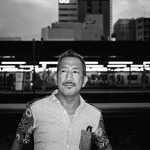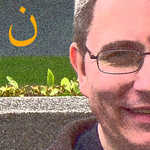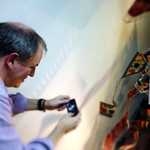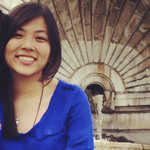Uplifting and encouraging peers are generally a rarity, especially coming from genuine places — not with these guys. There is this camaraderie of mutual respect and appreciation for each others’ works that is visible through their interactions. These three are truly, something else.
We are still sitting in the Snack Bar, Luis is still sketching away but he takes a second to lift his head and prompts me to flip through Adrian’s sketchbook.
”You should check-out his work, it’s really good.” he states, then puts his head-back down into his notebook.
Adrian, is still a bit uneasy in the Snack Bar but I look over and ask: “May I?” to which he says “of course” and plops the notebook in front of me. I take some hand-wipes to clean any grease or sugar granules or whatever else random crumbles from the cheap snacks off my fingers and gingerly pick-up his treasured prize. (I may be tipsy but my manners are intact — it’s the Japanese upbringing I tell you. Thank you, Mom!) I start flipping through the pages and I cannot stop — Adrian is really talented. There are illustrations of restaurants, landscapes, and sketches of people on the trains, streets, cafes, basically anywhere he is in the moment. He captures the essence of the Japanese in their daily states and I can’t help but be drawn in.
By this time, about an hour has gone by, the novelty of the Snack Bar has worn-off. We are still a bit hyper from the cheap snacks we inhaled and I get the vibe we are ready to move-on.
Adrian and Sophie call it a night and it’s me, Melissa and Matt, Luis and Graeme. It’s close to midnight and I know I have to take Matt and Melissa to Yokocho.
Yokocho’s characters 横丁・横町 means side city, and translates to alleyways off the side of major streets. The origin of the word comes from describing the passages of Tokyo when it was still called Edo between 1603-1868[^1]. These alleys were garbage depots and sewage canals but as the population of Edo grew, waste required to be properly maintained. Soon the side-streets were cleared of the waste and sewage. The people of Edo decided to use the empty space and built food stands or tiny eateries. There were even squatters who took the handles and wheels off their food carts and brought them into Yokochos. In modern day, Yokocho means a passageway of food stands.
In Ebisu, I am fortunate to reside near one of the vibrant Yokochos of Tokyo. I bring all visitors there to experience it at least once.
As we bid farewell to Sophie and Adrian, Luis, Graeme, Matt, Melissa, and I head to the other-side of the station. Next to a 7-11 and a run-down ramen and as of late, tourists, or is it yakitori? shop, there is a traditional Japanese sliding door with paddles of colorful squares on top.
Rolling the door to the side exposes a scene of inebriated salary men, groups of girls dressed to the nine, a sprinkle of non-Japanese faces. Ebisu Yokocho is popular with tourists as of late. People are cramped around tables made of crates, and benches made for two. The teeny counters where the food is prepared fits one or two people behind them at the most. There are stands on stands, serving a hodge-podge of Japanese small plates. I normally choose any place that has empty seats. (Actually, my favorite is the beef tongue place around the corner from the wine bar and across the way from the okonomiyaki place. That explanation sounds like nonsense so if you’re ever in Tokyo, do please let me know and I will be happy to take you.)
We end up at the hormone grill at the far end of the Yokocho. Hormone, are innards (skin, heart, liver, etc., etc.,) which sounds awful when translated into English but really not. Put it this way: if you can eat XLB (xiao long bao — Taiwanese soup dumplings) that have ground pig feet and chicken stomach lining in the filling, then you can consume the small plates from this eatery. For added assurances, I don’t fancy innards on skewers and when they are piled on a plate intact? Forget about it. Oddly shaped farm animal parts should be saved for biology text books. Liver makes me queasy — even foie gras oh, the humanity! So if I can eat foods from this place, you can too.
The five of us sit in the middle table and we are told we need to order a plate per person. At this point, we aren’t all that hungry but the rules are the rules. Luis already has his notebook pulled out drawing away while chatting with Graeme and Mike. Melissa and I are laughing about the quirks of Japan when out of the corner of my eye, I notice something on the next table over.
There is a group of young salary men drinking the same drink and I can’t stop staring at the colossal mugs filled with a clear liquid. There is half a lemon floating inside and topped with a triangular mound of ice cream or sherbert or shaved ice or something equally happy looking, that made me want one too. I couldn’t stop staring, they looked like Disney Land in a cup. I had to find out what it was. The slightly drunk salary men saw me looking over at them, waved, and started awkwardly salutating in English. That gesture was so endearing, I almost hid that I spoke Japanese. But my immediate goal was getting that drink, in my hand. I greet them in Japanese, apologize for staring, and they laugh with relief. We break into easy conversation as they describe the drink, tell me the name, and offer a taste out of their mugs. Cute. I thank them for their generosity but decline, and order one for myself, Mike, and Melissa. It was delicious. I am sorry to report I forgot the drink’s name. I have the short-term memory of a goldfish: three seconds and poof, in one ear, out the other. At least I sketched it vividly in my memory to order the next time around.
By this time, it’s getting late and Graeme needs to catch his last train. We bid farewell and it’s Mike, Melissa, Luis, and myself left. We down the rest of our drinks so we can move on. What? This is Tokyo. There are still two more stops.
To be cont…
Further reading on Ebisu Yokocho if you’re interested here. “[^1]: http://en.wikipedia.org/wiki/History_of_Tokyo#Edo_or_Tokugawa_period.2C_1603-1868”
Filed Under
Other moments in Tokyo
-
Conversations, World Affairs, Culture
"I'm from Libya," he said. I don't know what to say. It's as if he'd told me he'd just come from his father's funeral.
in Tokyo, Japan -
The first specialty coffee shop in Ikebukuro and Junkudo (bookstore) resonate.
in Tokyo, Japan -
film, edit
Editing is interpreting.
in Tokyo, Japan -
The Riddle of Steel.
in Tokyo, Japan -
Commutes, Cities, Underground
The man stands motionless in a crush of white-shirted salarymen, as they swarm past him, toward the single escalator.
in Tokyo, Japan -
Reve, japan, Centre commercial piscine
Rêve de centre commercial-piscine
in Tokyo, Japan -
Urban Nature, birds
Sparrow Noise
in Tokyo, Japan -
City walks
Birthday walk home
in Tokyo, Japan -
Dead Letter, Addiction
"Dear Cigarettes"
in Tokyo, Japan










